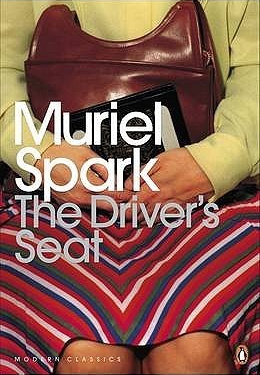“I want to go back home and feel all that lonely grief again”
This was a bleak book from the very first page, and it quickly became unsettling to follow due to its fragmented narrative and disjointed yet intriguing dialogue. I believe Muriel Spark deliberately uses these techniques to reflect the chaotic, unstable psyche of our protagonist, Lise. Her tragic fate is revealed early on in Chapter 3, which shaped my perspective on the rest of the book. This isn’t the typical “whodunit,” but rather a unique exploration of a “whynit”—why Lise made the choices that ultimately led to her devastating fate.
Synopsis
Muriel Spark opens with a significant scene that unveils Lise’s instability and hidden motives. In a clothing store, Lise causes a commotion over a “stainless” fabric, a seemingly trivial outburst that takes on darker meaning by the book’s end. Lise doesn’t want her clothes to stay stainless; she wants them to absorb blood, hinting at her self-destructive intentions from the start.
After leaving, she heads to another store, selecting bright, eccentric clothes—a stark contrast to the dull practicality of her life as an accountant. Overwhelmed by the mundanity of her routine, she embarks on what initially seems to be a search for love—or perhaps an illusory “boyfriend.” However, her purpose soon becomes clear as something much darker.
On her holiday, she encounters a series of characters who play pivotal roles in her tragic narrative: Bill, a macrobiotic cult fanatic; Mrs. Fiedke, an elderly traveller; Carlo, a creepy mechanic; and finally, Richard, a man she identifies as “her type” and believes is destined to fulfil her request. Through a series of unsettling encounters, she ultimately manipulates Richard, a disturbed man, into fulfilling her self-destructive fate.
Alienation, Trauma, and Sexual Disdain
Lise’s trauma reveals itself overwhelmingly through her interactions, behaviour, and growing alienation, leading towards inevitable self-destruction.
Her disdain for societal norms emerges in her mocking reaction to Bill’s “yang” pretentious philosophy, which he uses to establish control over her. To Lise, his self-important views are hollow, another societal superficiality. She scorns other women in “specially short” skirts, typical for summer, while she chooses “old-fashioned length” clothing. This choice hints at her discomfort with sexuality, perhaps rooted in past trauma, as she stands apart from conventional femininity, “conspicuous… in the particular mixture of her colours.” Her attire boldly rebels against the modern world, amplifying her alienation.
Her painful experiences with men deepen this alienation.
Carlo’s aggressive advances, culminating in an attempted assault after a chaotic student riot, force her to leap from his car and later steal it to escape. Her night only worsens when she encounters Bill again. Ignoring her bleak confession that “sex is all right… at the time,” but “the problem is afterwards.” Bill ignores her bleak view of intimacy, seeking only ‘yang’ fulfilment through an “orgasm”. Bill’s blatant indifference to her perspective on intimacy reinforces her belief that men are purely animalistic, viewing her as less than human. This repeated pattern of abuse intensifies her grief and likely compounds a history of sexual trauma, ultimately convincing her that men, in her view, are all the same.
It’s striking that Lise tells every man she meets on her trip that she’s “looking for her boyfriend”—a possible defence mechanism. By contrast, with female characters like Mrs. Fiedke or the woman from Johannesburg, she appears more comfortable, even manipulating Mrs. Fiedke with relative ease. This contrast illustrates how vulnerable she feels around men and reveals a stark difference in her interactions, emphasising her discomfort with male counterparts.
Self-Destruction and the Search for a “Type”
Lise’s venture is inherently about finding someone whose chaotic psyche mirrors her own.
When she meets Richard, she declares he is “her type,” yet this attraction is rooted in a twisted recognition of shared instability and dark nature. While Lise’s darkness appears to stem from traumatic experiences, Richard’s feels almost innate, as though he was born with it. Lise, a perceptive judge of character, identifies him early on as someone who, like her, is detached from societal norms and capable of fulfilling her ultimate, self-destructive desires.
This recognition between them is unsettlingly mutual.
After her death, the police reveal that Richard was initially “afraid” of her, moving seats on the plane to avoid her. It’s as if he sensed something deeply disturbed within her, a dark resonance that transcends physical attraction. This suggests that Lise’s search for “her type” was, in reality, a search for someone who could not only see her inner darkness but match it with his own. Richard’s reaction hints that he recognised her fatal intentions from the start, aware that she might draw him back into his own dark tendencies.
Manipulation and Mirroring of Trauma
Muriel Spark uses Richard as a mirror to expose the depths of Lise’s trauma.
By guiding Richard step-by-step through the act of killing her, Lise manipulates him to carry out her fatalistic desires, showing a chilling commitment to her own self-destruction. Lise detailed instructions, including how to use the sheath taken from Mrs. Fiedke, convey her complete surrender to despair. The brutality of her premediated end is intensified by her decision to use the gifts she bought as restraints—including scarves, she had intended as “family gifts.” This dark twist reveals her abandonment of hope, symbolically severing any final bonds to family or life itself.
Through this dynamic, Spark reveals how trauma and despair twist relationships, drawing individuals toward those who mirror their own damage. Lise’s disturbing connection with Richard highlights the novella’s exploration of identity and psychological nihilism, revealing how her trauma has completely eroded her self-worth.
If you enjoy…
For readers drawn to dark, complex psychological themes, The Driver’s Seat is a standout.
Lise’s character fascinates me, though I wish there had been more details of her past woven into the narrative—perhaps making it a five-star read.
Have you read this book?
We would love to hear your thoughts on this book, perhaps you agree with our review, or, disagree?





